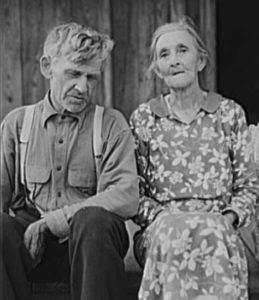Our parents and grandparents may shake their heads every time we grab our smart phones to get turn-by-turn directions or calculate the tip. But when it comes to life skills, our great-grandparents have us all beat. Here are some skills our great-grandparents had 90 years ago that most of us don’t.

1. Courting
While your parents and grandparents didn’t have the option to ask someone out on a date via text message, it’s highly likely that your great-grandparents didn’t have the option of dating at all. Until well into the 1920s, modern dating didn’t really exist. A gentleman would court a young lady by asking her or her parents for permission to call on the family. The potential couple would have a formal visit — with at least one parent chaperone present — and the man would leave a calling card. If the parents and young lady were impressed, he’d be invited back again and that would be the start of their romance.
2. Hunting, Fishing, and Foraging
Even city dwellers in your great-grandparents’ generation had experience hunting, fishing, and foraging for food. If your great-grandparents never lived in a rural area or lived off the land, their parents probably did. Being able to kill, catch, or find your own food was considered an essential life skill no matter where one lived, especially during the Great Depression.

3. Butchering
In this age of the boneless, skinless chicken breast, it’s unusual to have to chop up a whole chicken at home, let alone a whole cow. Despite the availability of professionally butchered and packaged meats, knowing how to cut up a side of beef or butcher a rabbit from her husband’s hunting trip was an ordinary part of a housewife’s skill set in the early 20th century. This didn’t leave the men off the hook, though. After all, they were most likely the ones who would field dress any animals they killed.
4. Bartering
Before the era of shopping malls and convenience stores, it was more common to trade goods and services with neighbors and shop owners. Home-canned foods, hand-made furniture, and other DIY goods were currency your great-grandparents could use in lieu of cash.
5. Haggling
Though it’d be futile for you to argue with the barista at Starbucks about the price of a cup of coffee, your great-grandparents were expert hagglers. Back when corporate chains weren’t as ubiquitous, it was a lot easier to bargain with local shop owners and tradesmen. Chances are your great-grandparents bought very few things from a store anyway.
6. Darning and mending
Nowadays if a sock gets a hole in it, you buy a new pair. But your great-grandparents didn’t let anything go to waste, not even a beat-up, old sock. This went for every other article of clothing as well. Darning socks and mending clothes was just par for the course.
7. Corresponding by mail
Obviously, your great-grandparents didn’t text or email. However, even though the telephone existed, it wasn’t the preferred method of staying in touch either, especially long-distance. Hand-written letters were the way they communicated with loved ones and took care of business.

8. Making Lace
Tatting, the art of making lace, was a widely popular activity for young women in your great-grandparents’ generation. Elaborate lace collars, doilies, and other decorative touches were signs of sophistication. However, fashion changed and technology made lace an easy and inexpensive to buy, so their children probably didn’t pick up the skill.
9. Lighting a Fire Without Matches
Sure, matches have been around since the 1600s. But they were dangerous and toxic — sparking wildly out of control and emitting hazardous fumes. A more controllable, non-poisonous match wasn’t invented until 1910. So Great-grandma and Great-grandpa had to know a thing or two about lighting a fire without matches.

10. Diapering With Cloth
Disposable diapers weren’t patented until 1948 and it was another decade or two before they became widely used. Until then, cloth diapers held with safety pins were where babies did their business. Great-grandma had a lot of unpleasant laundry on her hands.
11. Writing With a Fountain Pen
While it’s true that your grandparents were skilled in the lost art of writing in cursive, your grandparents probably were, too. However, the invention of the ballpoint pen in the late 1930s and other advances in pen technology mean that your great-grandparents were the last generation who had to refill their pens with ink.
No comments:
Post a Comment